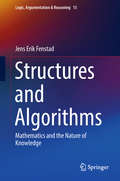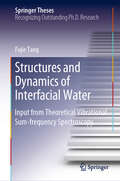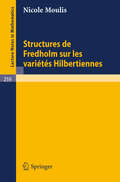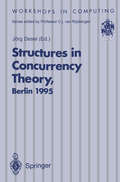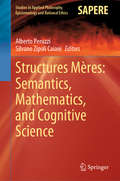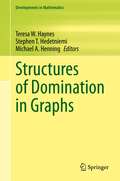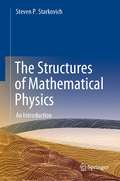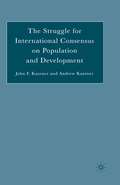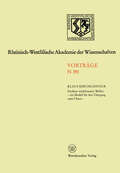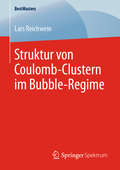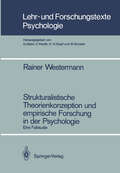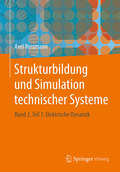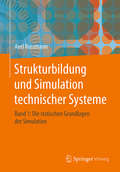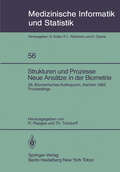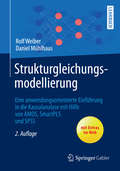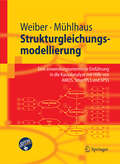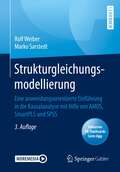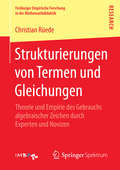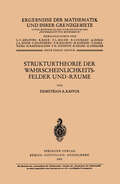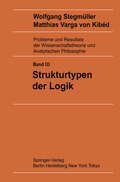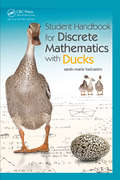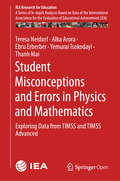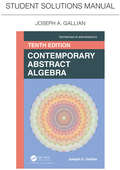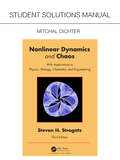- Table View
- List View
Structures and Algorithms: Mathematics and the Nature of Knowledge (Logic, Argumentation & Reasoning #15)
by Jens Erik FenstadThis book explains exactly what human knowledge is. The key concepts in this book are structures and algorithms, i.e., what the readers “see” and how they make use of what they see. Thus in comparison with some other books on the philosophy (or methodology) of science, which employ a syntactic approach, the author’s approach is model theoretic or structural. Properly understood, it extends the current art and science of mathematical modeling to all fields of knowledge. The link between structure and algorithms is mathematics. But viewing “mathematics” as such a link is not exactly what readers most likely learned in school; thus, the task of this book is to explain what “mathematics” should actually mean. Chapter 1, an introductory essay, presents a general analysis of structures, algorithms and how they are to be linked. Several examples from the natural and social sciences, and from the history of knowledge, are provided in Chapters 2–6. In turn, Chapters 7 and 8 extend the analysis to include language and the mind. Structures are what the readers see. And, as abstract cultural objects, they can almost always be seen in many different ways. But certain structures, such as natural numbers and the basic theory of grammar, seem to have an absolute character. Any theory of knowledge grounded in human culture must explain how this is possible. The author’s analysis of this cultural invariance, combining insights from evolutionary theory and neuroscience, is presented in the book’s closing chapter. The book will be of interest to researchers, students and those outside academia who seek a deeper understanding of knowledge in our present-day society.
Structures and Dynamics of Interfacial Water: Input from Theoretical Vibrational Sum-frequency Spectroscopy (Springer Theses)
by Fujie TangThis book focuses on the study of the interfacial water using molecular dynamics simulation and experimental sum frequency generation spectroscopy. It proposes a new definition of the free O-H groups at water-air interface and presents research on the structure and dynamics of these groups. Furthermore, it discusses the exponential decay nature of the orientation distribution of the free O-H groups of interfacial water and ascribes the origin of the down pointing free O-H groups to the presence of capillary waves on the surface. It also describes how, based on this new definition, a maximum surface H-bond density of around 200 K at ice surface was found, as the maximum results from two competing effects. Lastly, the book discusses the absorption of water molecules at the water–TiO2 interface. Providing insights into the combination of molecular dynamics simulation and experimental sum frequency generation spectroscopy, it is a valuable resource for researchers in the field.
Structures de Fredholm sur les Varietes Hilbertiennes (Lecture Notes in Mathematics #259)
by N. MoulisStructures in Concurrency Theory: Proceedings of the International Workshop on Structures in Concurrency Theory (STRICT), Berlin, 11–13 May 1995 (Workshops in Computing)
by Jorg DeselThis book is the proceedings of the Structures in Concurrency Theory workshop (STRICT) that was held from 11 th to l3th May 1995 in Berlin, Germany. It includes three invited contributions - by J. de Bakker, E. Best et aI, and E. R. Olderog and M. Schenke - and all papers which were submitted and accepted for presentation. Concurrency Theory deals with formal aspects of concurrent systems. It uses partly competing and partly complementary formalisms and structures. The aim of this workshop was to present and compare different formalisms and results in Concurrency Theory. STRICT was organized by the Humboldt-University Berlin and the ESPRIT Basic Research Working Group CALIBAN. Original papers had been sought from all scientists in the field of Concurrency Theory. The Programme Committee selected twenty contributions with various different topics, including Petri Nets, Process Algebras, Distributed Algorithms, Formal Semantics, and others. I am grateful to the Programme Committee and to the other referees for the careful evaluation of the submitted papers.
Structures Mères: Semantics, Mathematics, and Cognitive Science (Studies in Applied Philosophy, Epistemology and Rational Ethics #57)
by Alberto Peruzzi Silvano Zipoli CaianiThis book reports on cutting-edge concepts related to Bourbaki’s notion of structures mères. It merges perspectives from logic, philosophy, linguistics and cognitive science, suggesting how they can be combined with Bourbaki’s mathematical structuralism in order to solve foundational, ontological and epistemological problems using a novel category-theoretic approach. By offering a comprehensive account of Bourbaki’s structuralism and answers to several important questions that have arisen in connection with it, the book provides readers with a unique source of information and inspiration for future research on this topic.
Structures of Domination in Graphs (Developments in Mathematics #66)
by Teresa W. Haynes Stephen T. Hedetniemi Michael A. HenningThis volume comprises 17 contributions that present advanced topics in graph domination, featuring open problems, modern techniques, and recent results. The book is divided into 3 parts. The first part focuses on several domination-related concepts: broadcast domination, alliances, domatic numbers, dominator colorings, irredundance in graphs, private neighbor concepts, game domination, varieties of Roman domination and spectral graph theory. The second part covers domination in hypergraphs, chessboards, and digraphs and tournaments. The third part focuses on the development of algorithms and complexity of signed, minus and majority domination, power domination, and alliances in graphs. The third part also includes a chapter on self-stabilizing algorithms. Of extra benefit to the reader, the first chapter includes a glossary of commonly used terms.The book is intended to provide a reference for established researchers in the fields of domination and graph theory and graduate students who wish to gain knowledge of the topics covered as well as an overview of the major accomplishments and proof techniques used in the field.
The Structures of Mathematical Physics: An Introduction
by Steven P. StarkovichThis textbook serves as an introduction to groups, rings, fields, vector and tensor spaces, algebras, topological spaces, differentiable manifolds and Lie groups --- mathematical structures which are foundational to modern theoretical physics. It is aimed primarily at undergraduate students in physics and mathematics with no previous background in these topics. Applications to physics --- such as the metric tensor of special relativity, the symplectic structures associated with Hamilton's equations and the Generalized Stokes's Theorem --- appear at appropriate places in the text. Worked examples, end-of-chapter problems (many with hints and some with answers) and guides to further reading make this an excellent book for self-study. Upon completing this book the reader will be well prepared to delve more deeply into advanced texts and specialized monographs in theoretical physics or mathematics.
The Struggle for International Consensus on Population and Development
by J. KantnerTracing the population assistance movement from its tentative beginnings to today, this book employs history to examine the new paradigm created from the Cairo Conference - the 'road map' for the population policy future. The authors take stock of the current state and progress of the paradigm and explore policies and strategies for the future.
Struktur nichtlinearer Wellen - ein Modell für den Übergang zum Chaos -: 378. Sitzung am 6. November 1991 in Düsseldorf (Rheinisch-Westfälische Akademie der Wissenschaften #393)
by Klaus KirchgässnerStruktur von Coulomb-Clustern im Bubble-Regime (BestMasters)
by Lars ReichweinLars Reichwein untersucht die Struktur des beschleunigten Elektronenbündels im Bubble-Regime auf numerischem Wege und leitet analytische Skalierungsgesetze her. Durch die fokussierenden Effekte der äußeren elektromagnetischen Felder und der repulsiven Coulomb-Wechselwirkung entstehen regelmäßige Coulomb-Cluster, genannt Wigner-Kristalle. Deren Aufbau ist von besonderem Interesse, da Wakefield-Beschleunigung eine aussichtsreiche Alternative zu herkömmlichen Beschleunigungsmethoden darstellt, um auf möglichst kurzen Beschleunigungsstrecken hohe Teilchenenergien zu erhalten.
Strukturalistische Theorienkonzeption und empirische Forschung in der Psychologie: Eine Fallstudie (Lehr- und Forschungstexte Psychologie #25)
by Rainer WestermannStrukturbildung und Simulation technischer Systeme: Band 2, Teil 1: Elektrische Dynamik
by Axel RossmannTeil 1 des zweiten Bandes behandelt die Zeit- und Frequenz-Abhängigkeit elektrischer Systeme aus technischer Sicht. Mechanische Systeme bestehen aus Massen, Federn und Dämpfern. Elektrische Schaltungen bestehen aus Spulen, Kondensatoren und Widerständen. Mit diesen Bauelementen lassen sich die Basis-Systeme in Physik und Technik realisieren, wie zum Beispiel Oszillatoren.
Strukturbildung und Simulation technischer Systeme Band 1: Die statischen Grundlagen der Simulation
by Axel RossmannDer erste Teil der ‚Strukturbildung und Simulation technischer Systeme‘ erklärt die Strukturbildung. Strukturen zeigen graphisch, was - wie - womit berechnet werden soll. Sie sind die Grundlage der Simulation. Strukturen können von allen gängigen Simulations-Programmen berechnet werden. Durch Strukturbildung können Komponenten und Maschinen wie mit einem Teststand untersucht und optimiert werden, bevor man sie baut und ihre Komponenten beschafft. Das ist ein unschätzbarer Vorteil, denn Fehler werden schon in der Entwurfsphase erkannt und korrigiert.
Strukturen und Prozesse Neue Ansätze in der Biometrie: 28. Biometrisches Kolloquium der Biometrischen Gesellschaft Aachen, 16.–19. März 1982 Proceedings (Medizinische Informatik, Biometrie und Epidemiologie #56)
by R. Repges T. TolxdorffStrukturgleichungsmodellierung: Eine anwendungsorientierte Einführung in die Kausalanalyse mit Hilfe von AMOS, SmartPLS und SPSS (Springer-Lehrbuch)
by Rolf Weiber Daniel MühlhausAlle Analysen werden an einem durchgehenden Fallbeispiel konkret und transparent durchgeführt Strukturgleichungsmodelle sind in allen Wissenschaftsdisziplinen von größter Bedeutung, da sie das Standardinstrument zur empirischen Prüfung von Hypothesensystemen darstellen. Dabei stehen oftmals die Beziehungen zwischen hypothetischen Konstrukten (latenten Variablen) im Fokus des Interesses. Das Buch zeichnet den gesamten Prozess der Strukturgleichungsmodellierung von der Konzeptualisierung theoretischer Konstrukte über die Spezifikation von Messmodellen, die Reliabilitäts- und Validitätsprüfung mittels konfirmatorischer Faktorenanalyse bis hin zur Prüfung von kausalen Wirkhypothesen mittels Kovarianzstrukturanalyse sowie PLS nach. Alle Arbeitsschritte werden an einem durchgehenden Fallbeispiel unter Verwendung von SPSS, AMOS und SmartPLS veranschaulicht und jeweils konkrete Anwendungsempfehlungen gegeben. Ebenso werden weiterführende Aspekte wie die Mehrgruppenkausalanalyse, die Spezifikation reflektiver und formativer Messansätze sowie MIMIC-Modelle einsteigergerecht behandelt.
Strukturgleichungsmodellierung: Eine anwendungsorientierte Einführung in die Kausalanalyse mit Hilfe von AMOS, SmartPLS und SPSS (Springer-Lehrbuch)
by Rolf Weiber Daniel MühlhausStrukturgleichungsmodelle sind in allen Wissenschaftsdisziplinen von größter Bedeutung, da sie das Standardinstrument zur empirischen Prüfung von Hypothesensystemen darstellen. Dabei stehen oftmals die Beziehungen zwischen hypothetischen Konstrukten (latenten Variablen) im Fokus des Interesses. Das Buch zeichnet den gesamten Prozess der Strukturgleichungsmodellierung von der Konzeptualisierung theoretischer Konstrukte über die Spezifikation von Messmodellen, die Reliabilitäts- und Validitätsprüfung mittels konfirmatorischer Faktorenanalyse bis hin zur Prüfung von kausalen Wirkhypothesen mittels Kovarianzstrukturanalyse sowie PLS nach. Alle Arbeitsschritte werden an einem durchgehenden Fallbeispiel unter Verwendung von SPSS, AMOS und SmartPLS veranschaulicht und jeweils konkrete Anwendungsempfehlungen gegeben. Ebenso werden weiterführende Aspekte wie die Mehrgruppenkausalanalyse, die Spezifikation reflektiver und formativer Messansätze sowie MIMIC-Modelle einsteigergerecht behandelt.
Strukturgleichungsmodellierung: Eine anwendungsorientierte Einführung in die Kausalanalyse mit Hilfe von AMOS, SmartPLS und SPSS
by Rolf Weiber Marko SarstedtStrukturgleichungsmodelle stellen das Standardinstrument zur empirischen Prüfung von hypothetisierten Beziehungen zwischen theoretischen Konstrukten (latenten Variablen) dar. Das Buch zeichnet den gesamten Prozess der Strukturgleichungsmodellierung von der Konzeptualisierung theoretischer Konstrukte über die Spezifikation von Messmodellen, die Reliabilitäts- und Validitätsprüfung mittels konfirmatorischer Faktorenanalyse bis hin zur Prüfung von kausalen Wirkungshypothesen auf Basis der Kovarianzstrukturanalyse sowie der Partial Least Squares-Pfadmodellierung nach.Die einzelnen Analysen werden so erläutert, dass geringstmögliche mathematische Vorkenntnisse erforderlich sind. Alle Arbeitsschritte werden an einem durchgehenden Fallbeispiel unter Verwendung von SPSS, AMOS und SmartPLS veranschaulicht. Zu allen Arbeitsschritten werden klare Anwendungsempfehlungen sowie Hinweise zum Umgang mit unerwarteten Analyseergebnissen gegeben. Die Verwendung der jeweiligen Software wird ausführlich durch Screenshots erläutert. Für die 3. Auflage wurde das Buch umfassend überarbeitet, um die jüngsten methodischen Entwicklungen abzudecken. Besonderer Fokus wurde auf die Ausführungen zur PLS-Pfadmodellierung und Darstellung alternativer Schätzverfahren der Kausalanalyse gelegt. Das Angebot wurde zudem um digitale Lernkarten (Flashcards) erweitert, welche es dem Leser ermöglichen, das Wissen aus dem Buch zu vertiefen.Die ZielgruppenDas Buch richtet sich an Studierende und Lehrende in Master- und Doktorandenprogrammen sowie an Anwender aus der Unternehmens- und insbesondere Marktforschungspraxis. Es ist von besonderem Nutzen für alle, die Wirkungshypothesen zwischen latenten Variablen empirisch prüfen möchten. Das Fallbeispiel ist so allgemein gehalten, dass der Anwender die Analysen leicht auf spezifische Fragen und Probleme in seinen jeweiligen Anwendungsfeldern übertragen kann.Über die Internetseite www.strukturgleichungsmodellierung.de haben die Leserinnen und Leser Zugriff auf alle im Buch verwendeten Datensätze und Analyseskripte sowie weitere Serviceleistungen.
Strukturierungen von Termen und Gleichungen: Theorie und Empirie des Gebrauchs algebraischer Zeichen durch Experten und Novizen (Freiburger Empirische Forschung in der Mathematikdidaktik)
by Christian RüedeChristian Rüede geht davon aus, dass Schwierigkeiten der Schülerinnen und Schüler beim algebraischen Umformen auf Probleme beim Strukturieren von Termen und Gleichungen zurückzuführen sind. Er verschiebt den Fokus von der Struktur auf die Strukturierung eines Terms und einer Gleichung und stellt so die individuellen Lern- und Denkwege in den Vordergrund. Der Autor legt einen theoretischen Rahmen vor, um den Begriff der Strukturierung zu fundieren und unterschiedliche, empirisch basierte Kategorien von Strukturierungen begrifflich zu fassen. Ausgehend von diesen theoretischen und empirischen Betrachtungen stellt er eine Hypothese auf, wie sich bei einem Individuum das Strukturieren von Termen und Gleichungen entwickelt.
Strukturtheorie der Wahrscheinlichkeitsfelder und -Räume (Ergebnisse der Mathematik und ihrer Grenzgebiete. 2. Folge #24)
by Demetrios A. KapposStrukturtypen der Logik (Probleme und Resultate der Wissenschaftstheorie und Analytischen Philosophie #3)
by Matthias Varga Von KibedDiese Absicht wurde verstärkt durch den äußeren Umstand, daß in zunehmendem Maße Mathematikstudenten der Münchner Universität bei mir Logik als Nebenfach wählten. Da diese Kandidaten meist keine Zeit und Gelegenheit hatten, meine Veranstaltungen zu besuchen, kam der verständliche Wunsch auf, ich möge "etwas Schriftliches verfassen", das man mit nach Hause nehmen könne. Hinzu kam schließlich noch das Wissen um didaktische Nachteile vieler Logik-Bücher. In den meisten von ihnen werden nur spezielle syntaktische und semantische Verfahren behandelt. Wenn z. B. in einem Werk ausschließlich die axiomatische Methode, in einem weiteren allein das natürliche Schließen und in einem dritten nur der Kalkül der PositivfNegativ-Teile vorgeführt wird, so fällt es selbst einem routinier ten Mathematiker schwer, die Gleichwertigkeit dieser Kalkülisierungen einzusehen. Weichen dann auch noch die Systematisierungen der Se mantik erheblich voneinander ab, so wird ein Nichtmathematiker ver mutlich sogar den Eindruck gewinnen, die fraglichen Bücher handelten von verschiedenen Gegenständen. Doch dies ist nur die eine Seite der Medaille. In immer mehr Bücher, die das Wort ,Logik' im Titel tragen, werden nämlich umgekehrt mehr oder weniger ausführlich Bereiche einbezogen, die zwar für Untersuchungen zur Logik von Wichtigkeit sind, die jedoch weit über den Rahmen der Logik hinausführen, wie z. B. Rekursionstheorie, axiomatische Mengenlehre oder Hilbertsche Beweis theorie. Zieht man die Grenze einmal so weit, so ist nicht zu erkennen, warum nicht noch viel mehr einbezogen werden sollte. In zunehmendem Maße spielen z. B. algebraische Begriffe eine wichtige Rolle bei logischen Untersuchungen.
Student Handbook for Discrete Mathematics with Ducks: SRRSLEH
by Sarah-Marie BelcastroStudent Handbook for Discrete Mathematics with Ducks is a Student Reference, Review, Supplemental Learning, and Example Handbook (SRRSLEH) that mirrors the content of the author's popular textbook Discrete Mathematics with Ducks (DMwD). This handbook provides a review of key material, illustrative examples, and new problems with accompanying soluti
Student Misconceptions and Errors in Physics and Mathematics: Exploring Data from TIMSS and TIMSS Advanced (IEA Research for Education #9)
by Teresa Neidorf Alka Arora Ebru Erberber Yemurai Tsokodayi Thanh MaiThis open access report explores the nature and extent of students’ misconceptions and misunderstandings related to core concepts in physics and mathematics and physics across grades four, eight and 12. Twenty years of data from the IEA’s Trends in International Mathematics and Science Study (TIMSS) and TIMSS Advanced assessments are analyzed, specifically for five countries (Italy, Norway, Russian Federation, Slovenia, and the United States) who participated in all or almost all TIMSS and TIMSS Advanced assessments between 1995 and 2015.The report focuses on students’ understandings related to gravitational force in physics and linear equations in mathematics. It identifies some specific misconceptions, errors, and misunderstandings demonstrated by the TIMSS Advanced grade 12 students for these core concepts, and shows how these can be traced back to poor foundational development of these concepts in earlier grades. Patterns in misconceptions and misunderstandings are reported by grade, country, and gender. In addition, specific misconceptions and misunderstandings are tracked over time, using trend items administered in multiple assessment cycles. The study and associated methodology may enable education systems to help identify specific needs in the curriculum, improve inform instruction across grades and also raise possibilities for future TIMSS assessment design and reporting that may provide more diagnostic outcomes.
Student Solutions Manual for Gallian's Contemporary Abstract Algebra (Textbooks in Mathematics)
by Joseph A. GallianWhereas many partial solutions and sketches for the odd-numbered exercises appear in the book, the Student Solutions Manual, written by the author, has comprehensive solutions for all odd-numbered exercises and large number of even-numbered exercises. This Manual also offers many alternative solutions to those appearing in the text. These will provide the student with a better understanding of the material. This is the only available student solutions manual prepared by the author of Contemporary Abstract Algebra, Tenth Edition and is designed to supplement that text. Table of Contents Integers and Equivalence Relations0. Preliminaries Groups1. Introduction to Groups 2. Groups 3. Finite Groups; Subgroups 4. Cyclic Groups 5. Permutation Groups 6. Isomorphisms 7. Cosets and Lagrange's Theorem 8. External Direct Products 9. Normal Subgroups and Factor Groups 10. Group Homomorphisms 11. Fundamental Theorem of Finite Abelian Groups Rings12. Introduction to Rings 13. Integral Domains14. Ideals and Factor Rings 15. Ring Homomorphisms 16. Polynomial Rings 17. Factorization of Polynomials 18. Divisibility in Integral Domains FieldsFields19. Extension Fields 20. Algebraic Extensions21. Finite Fields 22. Geometric Constructions Special Topics23. Sylow Theorems 24. Finite Simple Groups 25. Generators and Relations 26. Symmetry Groups 27. Symmetry and Counting 28. Cayley Digraphs of Groups 29. Introduction to Algebraic Coding Theory 30. An Introduction to Galois Theory 31. Cyclotomic Extensions Biography Joseph A. Gallian earned his PhD from Notre Dame. In addition to receiving numerous national awards for his teaching and exposition, he has served terms as the Second Vice President, and the President of the MAA. He has served on 40 national committees, chairing ten of them. He has published over 100 articles and authored six books. Numerous articles about his work have appeared in the national news outlets, including the New York Times, the Washington Post, the Boston Globe, and Newsweek, among many others.
Student Solutions Manual for Gallian's Contemporary Abstract Algebra (Textbooks in Mathematics)
by Joseph A. GallianWhereas many partial solutions and sketches for the odd-numbered exercises appear in the book, the Student Solutions Manual, written by the author, has comprehensive solutions for all odd-numbered exercises and large number of even-numbered exercises. This Manual also offers many alternative solutions to those appearing in the text. These will provide the student with a better understanding of the material. This is the only available student solutions manual prepared by the author of Contemporary Abstract Algebra, Tenth Edition and is designed to supplement that text. Table of Contents Integers and Equivalence Relations0. Preliminaries Groups1. Introduction to Groups 2. Groups 3. Finite Groups; Subgroups 4. Cyclic Groups 5. Permutation Groups 6. Isomorphisms 7. Cosets and Lagrange's Theorem 8. External Direct Products 9. Normal Subgroups and Factor Groups 10. Group Homomorphisms 11. Fundamental Theorem of Finite Abelian Groups Rings12. Introduction to Rings 13. Integral Domains14. Ideals and Factor Rings 15. Ring Homomorphisms 16. Polynomial Rings 17. Factorization of Polynomials 18. Divisibility in Integral Domains FieldsFields19. Extension Fields 20. Algebraic Extensions21. Finite Fields 22. Geometric Constructions Special Topics23. Sylow Theorems 24. Finite Simple Groups 25. Generators and Relations 26. Symmetry Groups 27. Symmetry and Counting 28. Cayley Digraphs of Groups 29. Introduction to Algebraic Coding Theory 30. An Introduction to Galois Theory 31. Cyclotomic Extensions Biography Joseph A. Gallian earned his PhD from Notre Dame. In addition to receiving numerous national awards for his teaching and exposition, he has served terms as the Second Vice President, and the President of the MAA. He has served on 40 national committees, chairing ten of them. He has published over 100 articles and authored six books. Numerous articles about his work have appeared in the national news outlets, including the New York Times, the Washington Post, the Boston Globe, and Newsweek, among many others.
Student Solutions Manual for Non Linear Dynamics and Chaos: With Applications to Physics, Biology, Chemistry, and Engineering
by Mitchal DichterThis official Student Solutions Manual includes solutions to the odd-numbered exercises featured in the third edition of Steven Strogatz's classic text Nonlinear Dynamics and Chaos: With Applications to Physics, Biology, Chemistry, and Engineering. The textbook and accompanying Student Solutions Manual are aimed at newcomers to nonlinear dynamics and chaos, especially students taking a first course in the subject. Complete with graphs and worked-out solutions, this manual demonstrates techniques for students to analyze differential equations, bifurcations, chaos, fractals, and other subjects Strogatz explores in his popular book.
